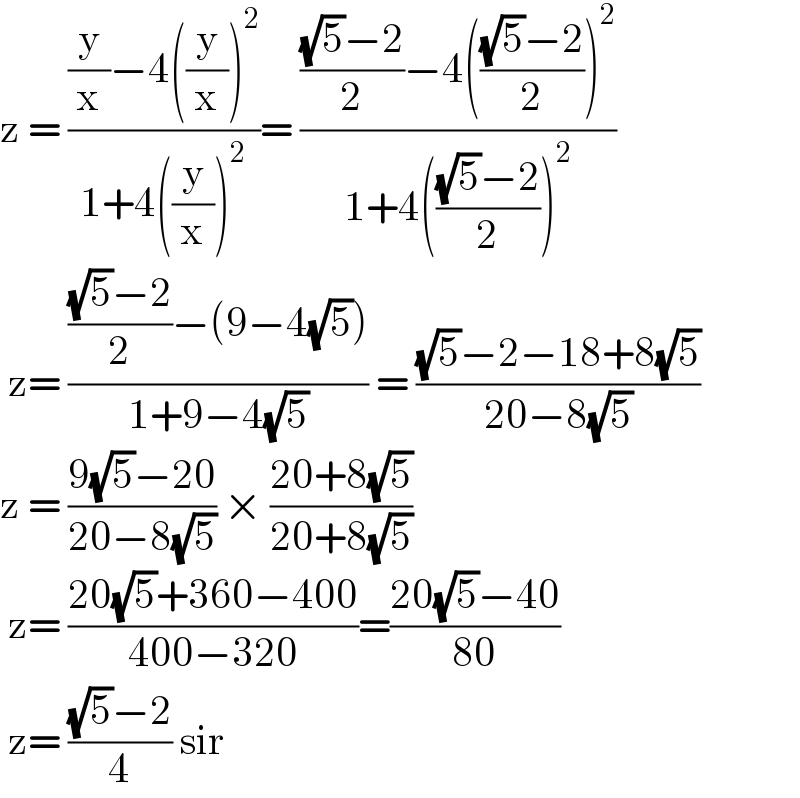
Question Number 132753 by liberty last updated on 16/Feb/21

$$\mathrm{Given}\:\mathrm{x},\mathrm{y}\:\in\mathbb{R}\:,\:\mathrm{x},\mathrm{y}\neq\:\mathrm{0} \\ $$$$\mathrm{Find}\:\mathrm{the}\:\mathrm{maximum}\:\mathrm{and}\:\mathrm{minimum} \\ $$$$\mathrm{value}\:\mathrm{of}\:\frac{\mathrm{xy}−\mathrm{4y}^{\mathrm{2}} }{\mathrm{x}^{\mathrm{2}} +\mathrm{4y}^{\mathrm{2}} }\: \\ $$
Commented by mr W last updated on 16/Feb/21

$${min}=−\frac{\sqrt{\mathrm{5}}+\mathrm{2}}{\mathrm{4}} \\ $$$${max}=\frac{\sqrt{\mathrm{5}}−\mathrm{2}}{\mathrm{4}} \\ $$
Commented by liberty last updated on 16/Feb/21

$$\mathrm{step}? \\ $$
Answered by EDWIN88 last updated on 16/Feb/21

$$\mathrm{let}\:\mathrm{z}=\mathrm{f}\left(\mathrm{x},\mathrm{y}\right)\:=\:\frac{\mathrm{xy}−\mathrm{4y}^{\mathrm{2}} }{\mathrm{x}^{\mathrm{2}} +\mathrm{4y}^{\mathrm{2}} } \\ $$$$\left(\mathrm{1}\right)\:\frac{\partial\mathrm{z}}{\partial\mathrm{x}}\:=\:\frac{\mathrm{y}\left(\mathrm{x}^{\mathrm{2}} +\mathrm{4y}^{\mathrm{2}} \right)−\mathrm{2x}\left(\mathrm{xy}−\mathrm{4y}^{\mathrm{2}} \right)}{\left(\mathrm{x}^{\mathrm{2}} +\mathrm{4y}^{\mathrm{2}} \right)^{\mathrm{2}} }\:=\:\mathrm{0} \\ $$$$\:\mathrm{we}\:\mathrm{get}\:\mathrm{x}^{\mathrm{2}} \mathrm{y}+\mathrm{4y}^{\mathrm{3}} −\mathrm{2x}^{\mathrm{2}} \mathrm{y}+\mathrm{8xy}^{\mathrm{2}} =\:\mathrm{0}...\left(\mathrm{i}\right) \\ $$$$\:\:\:\:\:\:\:\:\:\:\:\:\:\:\:\mathrm{4y}^{\mathrm{3}} −\mathrm{x}^{\mathrm{2}} \mathrm{y}+\mathrm{8xy}^{\mathrm{2}} \:=\:\mathrm{0} \\ $$$$\left(\mathrm{2}\right)\:\frac{\partial\mathrm{z}}{\partial\mathrm{y}}\:=\:\frac{\left(\mathrm{x}−\mathrm{8y}\right)\left(\mathrm{x}^{\mathrm{2}} +\mathrm{4y}^{\mathrm{2}} \right)−\mathrm{8y}\left(\mathrm{xy}−\mathrm{4y}^{\mathrm{2}} \right)}{\left(\mathrm{x}^{\mathrm{2}} +\mathrm{4y}^{\mathrm{2}} \right)^{\mathrm{2}} }=\:\mathrm{0} \\ $$$$\mathrm{we}\:\mathrm{get}\:\mathrm{x}^{\mathrm{3}} +\mathrm{4xy}^{\mathrm{2}} −\mathrm{8x}^{\mathrm{2}} \mathrm{y}−\mathrm{32y}^{\mathrm{3}} −\mathrm{8xy}^{\mathrm{2}} +\mathrm{32y}^{\mathrm{3}} \:=\:\mathrm{0} \\ $$$$\:\:\:\:\mathrm{x}^{\mathrm{3}} −\mathrm{4xy}^{\mathrm{2}} −\mathrm{8xy}\:=\:\mathrm{0}\:\mathrm{or}\:\mathrm{x}^{\mathrm{2}} −\mathrm{4y}^{\mathrm{2}} −\mathrm{8y}\:=\:\mathrm{0}\:...\left(\mathrm{ii}\right) \\ $$$$\mathrm{adding}\:\left(\mathrm{1}\right)\:\mathrm{and}\:\left(\mathrm{2}\right) \\ $$$$\Rightarrow\:\mathrm{8xy}−\mathrm{8y}\:=\:\mathrm{0}\:\Rightarrow\mathrm{x}\:=\:\mathrm{1}\:\:\mathrm{and}\:\mathrm{4y}^{\mathrm{2}} +\mathrm{8y}−\mathrm{1}=\mathrm{0} \\ $$$$\:\mathrm{y}\:=\:−\mathrm{1}\pm\:\frac{\sqrt{\mathrm{5}}}{\mathrm{2}}\:\mathrm{then}\:\mathrm{critical}\:\mathrm{point}\:\mathrm{is}\: \\ $$$$\mathrm{A}\left(\mathrm{1},−\mathrm{1}+\frac{\sqrt{\mathrm{5}}}{\mathrm{2}}\:\right)\:\mathrm{and}\:\mathrm{B}\:=\:\left(\mathrm{1},−\mathrm{1}−\frac{\sqrt{\mathrm{5}}}{\mathrm{2}}\right) \\ $$$$\mathrm{for}\:\mathrm{A}\Rightarrow\:\mathrm{z}=\frac{\mathrm{y}\left(\mathrm{x}−\mathrm{4y}\right)}{\mathrm{x}^{\mathrm{2}} +\mathrm{4y}^{\mathrm{2}} }\:=\:\frac{\sqrt{\mathrm{5}}−\mathrm{2}}{\mathrm{4}}\:\approx\:\mathrm{0}.\mathrm{05901} \\ $$$$\mathrm{for}\:\mathrm{B}\Rightarrow\mathrm{z}=\frac{−\sqrt{\mathrm{5}}−\mathrm{2}}{\mathrm{4}}\:\approx\:−\mathrm{1}.\mathrm{05901} \\ $$
Commented by EDWIN88 last updated on 16/Feb/21

$$\mathrm{yes}\:\mathrm{sir}.\:\mathrm{thank}\:\mathrm{you} \\ $$
Commented by liberty last updated on 16/Feb/21

$$\mathrm{waw}... \\ $$
Commented by liberty last updated on 16/Feb/21

$$\mathrm{z}\:=\:\frac{\frac{\mathrm{y}}{\mathrm{x}}−\mathrm{4}\left(\frac{\mathrm{y}}{\mathrm{x}}\right)^{\mathrm{2}} }{\mathrm{1}+\mathrm{4}\left(\frac{\mathrm{y}}{\mathrm{x}}\right)^{\mathrm{2}} }=\:\frac{\frac{\sqrt{\mathrm{5}}−\mathrm{2}}{\mathrm{2}}−\mathrm{4}\left(\frac{\sqrt{\mathrm{5}}−\mathrm{2}}{\mathrm{2}}\right)^{\mathrm{2}} }{\mathrm{1}+\mathrm{4}\left(\frac{\sqrt{\mathrm{5}}−\mathrm{2}}{\mathrm{2}}\right)^{\mathrm{2}} } \\ $$$$\:\mathrm{z}=\:\frac{\frac{\sqrt{\mathrm{5}}−\mathrm{2}}{\mathrm{2}}−\left(\mathrm{9}−\mathrm{4}\sqrt{\mathrm{5}}\right)}{\mathrm{1}+\mathrm{9}−\mathrm{4}\sqrt{\mathrm{5}}}\:=\:\frac{\sqrt{\mathrm{5}}−\mathrm{2}−\mathrm{18}+\mathrm{8}\sqrt{\mathrm{5}}}{\mathrm{20}−\mathrm{8}\sqrt{\mathrm{5}}} \\ $$$$\mathrm{z}\:=\:\frac{\mathrm{9}\sqrt{\mathrm{5}}−\mathrm{20}}{\mathrm{20}−\mathrm{8}\sqrt{\mathrm{5}}}\:×\:\frac{\mathrm{20}+\mathrm{8}\sqrt{\mathrm{5}}}{\mathrm{20}+\mathrm{8}\sqrt{\mathrm{5}}} \\ $$$$\:\mathrm{z}=\:\frac{\mathrm{20}\sqrt{\mathrm{5}}+\mathrm{360}−\mathrm{400}}{\mathrm{400}−\mathrm{320}}=\frac{\mathrm{20}\sqrt{\mathrm{5}}−\mathrm{40}}{\mathrm{80}} \\ $$$$\:\mathrm{z}=\:\frac{\sqrt{\mathrm{5}}−\mathrm{2}}{\mathrm{4}}\:\mathrm{sir} \\ $$
Answered by mr W last updated on 16/Feb/21

$${let}\:{k}=\frac{\mathrm{xy}−\mathrm{4y}^{\mathrm{2}} }{\mathrm{x}^{\mathrm{2}} +\mathrm{4y}^{\mathrm{2}} }=\frac{\mathrm{1}−\mathrm{4}\left(\frac{{y}}{{x}}\right)}{\left(\frac{{x}}{{y}}\right)+\mathrm{4}\left(\frac{{y}}{{x}}\right)}=\frac{\mathrm{1}−\mathrm{4}{t}}{\frac{\mathrm{1}}{{t}}+\mathrm{4}{t}}=\frac{{t}−\mathrm{4}{t}^{\mathrm{2}} }{\mathrm{1}+\mathrm{4}{t}^{\mathrm{2}} } \\ $$$${with}\:{t}=\frac{{y}}{{x}}\in{R} \\ $$$${k}+\mathrm{4}{kt}^{\mathrm{2}} ={t}−\mathrm{4}{t}^{\mathrm{2}} \\ $$$$\mathrm{4}\left({k}+\mathrm{1}\right){t}^{\mathrm{2}} −{t}+{k}=\mathrm{0} \\ $$$$\Delta=\mathrm{1}^{\mathrm{2}} −\mathrm{4}×\mathrm{4}\left({k}+\mathrm{1}\right){k}\geqslant\mathrm{0}\:{such}\:{that}\:{t}\in{R} \\ $$$${k}^{\mathrm{2}} +{k}−\frac{\mathrm{1}}{\mathrm{16}}\leqslant\mathrm{0} \\ $$$${k}_{\mathrm{1},\mathrm{2}} =\frac{\mathrm{1}}{\mathrm{2}}\left(−\mathrm{1}\pm\frac{\sqrt{\mathrm{5}}}{\mathrm{2}}\right)=−\frac{\sqrt{\mathrm{5}}+\mathrm{2}}{\mathrm{4}},\:\frac{\sqrt{\mathrm{5}}−\mathrm{2}}{\mathrm{4}} \\ $$$$\Rightarrow−\frac{\sqrt{\mathrm{5}}+\mathrm{2}}{\mathrm{4}}\leqslant{k}\leqslant\frac{\sqrt{\mathrm{5}}−\mathrm{2}}{\mathrm{4}} \\ $$$$\Rightarrow{min}=−\frac{\sqrt{\mathrm{5}}+\mathrm{2}}{\mathrm{4}} \\ $$$$\Rightarrow{max}=\frac{\sqrt{\mathrm{5}}−\mathrm{2}}{\mathrm{4}} \\ $$
Commented by liberty last updated on 16/Feb/21

$$\mathrm{thank}\:\mathrm{you}\:\mathrm{sir} \\ $$
